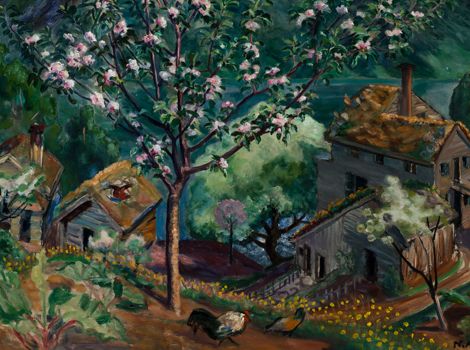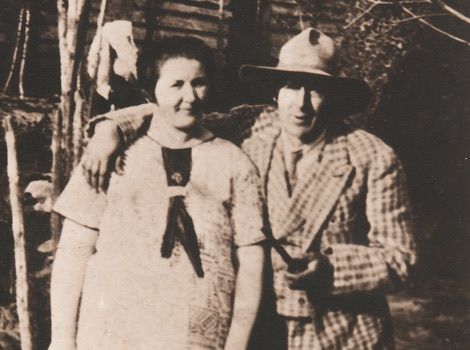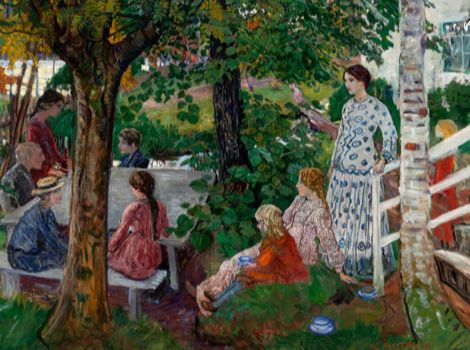Methodology
Briefly put, the work on a catalogue raisonné consists in mapping out the life story – the social biography – of the artworks. The catalogue shall present an authentic and chronological overview of the artist’s oeuvre – in this case Nikolai Astrup’s paintings, including technical specifications and an historical account of the provenance, bibliography and exhibition history of each individual work. The project is based on Øystein Loge’s catalogue of paintings from 1985 (Magister degree thesis), which was published in the book Gartneren under regnbuen (The Gardener under the Rainbow) in 1986. This catalogue consisted of 210 numbered works.
Loge’s numerical sequence “K” will form the basis of the numerical sequence during the project’s development phase, while new registrations will be marked “N”. An entirely new numerical sequence for the Astrup catalogue raisonné will be established in the final phase of the project.
The artist’s own compiled “catalogue” from 1927 is another a vital resource. This overview, which is often referred to as “Astrup’s list”, contains a summing up of more than 101 paintings, and includes brief descriptions and information about ownership. The overview was put together by the artist at the request of Magnhild Bukdahl Ødvin, who intended to write a biography and arrange an exhibition of his work (neither was ever realised). The list exists in two copies: as a rough draft and as an attachment in a letter. The numerical sequence is marked ”Astrup”.
The project encompasses a study of existing catalogues, document archives, manuscript collections, museum collections and private archives, as well as printed sources such as publications, exhibition catalogues, auction catalogues, secondary literature, newspapers and periodicals.
In addition to this, related works such as printing blocks, prints and drawings are important sources. In its methodology, the project complies with the guidelines for ethical research practice as outlined in “Guidelines for compiling a catalogue raisonné” (2014), by the Authentication in Art Foundation, The Hague.1
1 Vivian Endicott Barnett, Jilleen Nadolny, Katy Rogers, Eddy Schavemaker, og Marije Vellekoop, ved Authentication in Art Foundation, «Guidelines for compiling a catalogue raisonné» (2014). Tilgang: https://authenticationinart.org/pdf/Guidelines.pdf (nedlasta 11.11.2017).
Provenance
Provenance research is an essential part of a catalogue raisonné, in that it corroborates verification and ownership. An ideal provenance entry contains a complete history of ownership, the dates of ownership and ownership transference, information associated with the transfer of ownership, such as gift, inheritance or sale – and, if applicable, the intermediary who transmitted the work to a new owner, which might be a museum or gallery, private persons or auction houses – in addition to the location of the work throughout history. Complete provenance registers are rare, and provenance research can be a problematic and time-consuming task.2 Museum and collections registers are central sources, but they can be unorganised, inconsistent and incomplete.
In order for the provenance data to serve its function, former and present owners must be registered with a minimum of information. This includes the first and last names (name at birth, and any name changes or alternative names), date of birth, and death if applicable, in addition to contact information if available. The collection of provenance data touches on legal and ethical questions associated with privacy protection. This is one of the major concerns of the project.
When it comes to ethical practice in a museum context, the documentation of a collection shall include a description of the ownership history, but sensitive information, such as personal information and the like, should be held back when the public is allowed access to the collection data.3 According to the guidelines for ethical research, all research shall be carried out in accordance with fundamental consideration for privacy protection: Personal information shall be handled confidentially.4 When collecting information, access to the dataset of personal information should be limited to a defined group, and when publishing, unless permission has otherwise been given, the history of ownership shall be made anonymous, using the term “Private owner”. This requires secure data filing procedures, so that published personal data cannot be retraced.5
The project Nikolai Astrup Online Catalogue Raisonné upholds personal privacy via information letters, and declarations of agreement and of confidentiality in our dealings with the private owners of Astrup’s works. According to established rule, anyone born within the past 100 years is automatically made anonymous, unless permission is otherwise given by the owner.
2 International Foundation for Art Research, «Provenance guide». Tilgang: https://www.ifar.org/provenance_guide.php (nedlasta 13.11.2018).
3 Sjå punkt «2.20 Dokumentasjon av samlingen» og «2.22 Samlingssikkerhet og personvern» i: Norsk ICOM, «ICOMs museumsetiske regelverk» (2006). Tilgang: http://norskicom.no/det-etiske-regleverk/ (lesedato: 1.12.2018).
4 Sjå De nasjonale forskningsetiske komiteene sin artikkel «Spørsmål og svar: Ny lovgivning om personopplysninge – kva betyr det for forsking?» (2018; levande dokument). Tilgang: https://www.etikkom.no/Aktuelt/gdpr-og-forskning/ (lesedato: 20.3.2019).
5 Sjå til dømes Datatilsynets rettleiar «Anonymisering av personopplysningar (2015). Tilgang: https://www.datatilsynet.no/globalassets/global/regelverk/veiledere/anonymisering-veileder-041115.pdf (lesedato: 20.3.2019).
Dating
The dating of works is a major issue in the research on Astrup’s paintings. The artist rarely dated his paintings in the form of inscriptions, and in several cases these have been added posthumously and as such may be misleading. In Øystein Loge’s catalogue, for example, only 51 of 210 paintings are dated. The exhibition catalogues after 1980 contain a certain amount of dating, but these are often based on exhibition history. A number of paintings are thus dated “before 1908” because the work was exhibited in 1908 and therefore had to be painted before that. The exhibition “Norwegian Landscapes” (2016–17) made an issue of this in order to arrive at the most precise dating in the list of works as possible. Based on available source material many dating are marked as “ca.”.
The annotated catalogue requires more precise dating. Here the works are dated in the form of windows of time – a dating that signifies that the work was painted within a given time frame. Rather than “before 1908”, for example, it will read “1902–1908”, which indicates that the painting was made after Astrup had completed his studies in 1902 and before it was exhibited in 1908. Source material such as correspondence to and from Astrup, newspaper archives and museum and gallery registers would contribute towards further narrowing down such windows of time. The time frames will also indicate the time the artist used to complete a painting – a process that might last over several years.
Titles
An analysis of Øystein Loge’s catalogue, which currently represents the established titles, reveals that as many as 168 of the 210 titles are attributed to the paintings after Astrup’s death in 1928. The variation and potential between the titles before and after 1928, paves the way for returning as many of the titles as possible to Astrup’s own titles. For example the titles for the paintings Storehouse in Jølster and Children Playing were established by National Gallery’s (today the National Museum) cataloguing practice during the 20th century. Here it is germane to point to the original titles “Dismal Autumn Day” and “Dark Sunshine”, which were used in Astrup’s first solo exhibition in Blomqvist Art Dealers in 1905, and which appear more faithful to the artist’s idiom.
Changing, or reinstating, Astrup’s titles has been a continuous topic of discussion throughout the research project. The goal is to attribute the highest degree of authenticity to the titles, and in so doing become more representative of what the artist wished to express.
Combination of Painting and Print
A vital topic when working with Astrup’s oeuvre is the artist’s interest in, and experimentation with various techniques. This is especially evident in the combining of painting and printmaking. On the one hand, many graphic works are painted with various tools, a practice which creates a unique effect in the picture plane. On the other hand, the artist has also used printing blocks on the canvas support in addition to the brush, thus creating a combination work between printmaking and painting. An example of this is the painting A Morning in March (1920), where the key block for the woodcut motif Spring Night and Willow has given form to the tree. The mixed technique creates various effects in the picture plane, in the contrast between the brushstrokes and the graphic imprint.
This is a characteristic feature of Astrup’s oeuvre, and a form of experimenting that elevates Astrup to the ranks of early modern artists. This subject demands further research in the work on the CR; for example, how extensive was this mixed technique? Astrup’s printing blocks are in this respect an important resource in the study of Astrup’s paintings.
Technical Analysis
The technical aspect of art history deals with studies related to the artwork’s progress, painting techniques and material use. This is a major field of study in the museum sector, and there is great potential in the exchange of expertise between natural science and the humanities – as represented by the painting conservator and the art historian. Technical analyses are not within the scope of the Astrup catalogue raisonné, however. The information here is largely limited to the quite obvious: oil on canvas – and in some cases the support material is identified as paper, cardboard or board. The technical descriptions do not include mixed techniques either, even when it is the case. This information is based on observations and informed discussions, and is not systematically explained.


